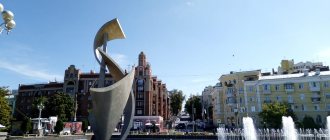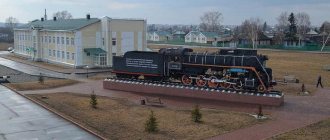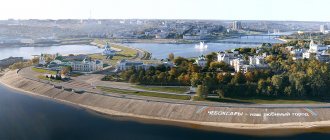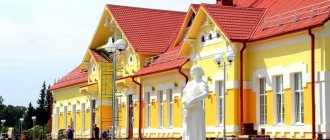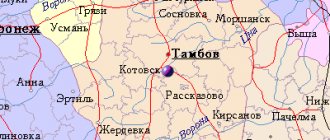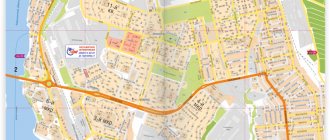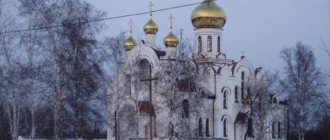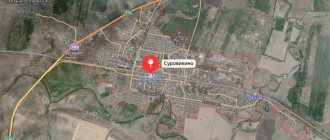This term has other meanings, see Asinovsky.
Asinovsky coat of arms (XXI century)
Asino
- a city in the Tomsk region, the administrative center of the municipal formation "Asinovsky District". Important railway node of the branch "Taiga - Tomsk - Asino - Bely Yar".
Also toponym Asino
- this is
railway station
, the city
port of the same name on the Chulym River
, the main place
of the Asinovsky urban settlement
.
General information
Population 27.7 thousand people. (2006), 70.1% of the population of the Asinovsky district.
The city is located on the left bank of the Chulym River (a tributary of the Ob), 109 km northeast of Tomsk. From Tomsk to Asin you can get along the P400 highway (Tomsk - Mariinsk), turning from it to the north between Khaldeevo and Podlomsk. Buses leave from the bus station several times a day; travel time is 3 hours. You can also get there by railway Taiga - Tomsk - Bely Yar on the daily train Tomsk-II - Asino.
Postal codes: 636810 - 636845.[1]. Telephone code: +7(38241) xx-xxx.
The head of the city and the chairman of the city council is Gennady Vladimirovich Logunov
.
Previously, the mayor of the city was Vera Krotova
. Deputies of the Asinovsky City Duma adopted a law according to which the mayor is elected not by city residents, but by the deputies themselves from among themselves.
2 newspapers are published: “Dissonance” and “Lifestyle. Region.” Also, until 2006, the regional newspaper “Our Prichulymye” (formerly “Prichulymskaya Pravda”) was regularly published. The regional journal “Environmental Education of the Tomsk Region: Problems, Experience, Prospects” is published in Asino[2].
Online media publication - Information site of the city of Asino - ASINO.TOMSK.RU
Television: ASTV-Ren TV (UHF channel 26, Asino TV LLC)
Radio stations: Radio “Siberian Wave” (VHF 69.50), “Avtoradio-Asino” (102.7 FM), “Asino-Fm”
The city of Asino in the Tomsk region
The settlement of Asino is a city located in the Tomsk region of the Russian Federation. The history of the city says that the appearance of its first streets is mentioned back in the 19th century. To a greater extent, it was a settlement for migrants, which was built on the coastal part of the Chulym River in the Tomsk region. The first inhabitants of the city were ordinary peasants who were forced to move to the Tomsk region for many reasons. The village began to be upset only after receiving permission for development from the administrative volost of the Tomsk region. In this regard, the settlement of migrants acquired the right to live and build a settlement in the Surgut section of the Novokuskovskaya volost, and already in 1897, the accumulated buildings of the settlement acquired the official status of a city called Ksentevka. Basically, the inhabitants of which were engaged only in agriculture and fishing. The settlement had to endure all the hardships during the First World War. The Kolchak regime reigned on the estate. The peasants also tried to overthrow him through an uprising in 1919, which was unsuccessful. After the uprising, its organizers were persecuted by the Ksenievo authorities, most of whom were exiled and later executed.
Since 1928, significant changes have occurred in the village, as a result of which, on the territory of the village, the first rural commune was created. Which later transformed into two independent collective farms, independent of each other. In the same year, most of the residents of Ksenyevka were recognized as kulaks and repressed to the distant lands of Siberia. IN 20
In the years of the last century, a new turn took place in the village; a timber mill and a sleeper factory were started and built on its territory, between which the first railway was built connecting the village with Tomsk. Since 1933, the village was renamed and registered under the name Asino. Over the years, the village grew, infrastructure appeared, and a flax mill began operating. Thanks to industry, people flocked to the settlement, the village grew and already in the 70s it became a major industrial center in the Tomsk region. In this regard, the village received the status of a city. This is how another city arose on the territory of the Tomsk region of the Russian Federation. To learn more about the history of the city, take a look at the Asinsky Museum of Local Lore. To make a tour of its surroundings, contact the cultural and tourist complex in the city for help. With its help, you will be able to visit the mysterious and ancient estates of the city, which will bring you a lot of pleasure.
Origin of the name
The name of the city comes from the name Asya
, which is a diminutive form of the name
Ksenia
.
The settlement was founded in 1895 as a resettlement village, in 1897 named Ksenyevka
, later the village of
Ksenyevsky
- in honor of
Ksenia Alexandrovna
, sister of Emperor Nicholas II.
June 7, 1933 village of Ksenyevka
renamed the village of
Asino
, after the name of the railway station.
At the same time, the Novo-Kuskovsky district received the name Asinovsky
[3].
Map
| Asino: maps |
Asino: photo from space (Google Maps) Asino: photo from space (Microsoft Virtual Earth)
| Asino. Nearest cities. Distances in km. on the map (in brackets along roads) + direction. Using the hyperlink in the distance , you can get the route (information courtesy of the AutoTransInfo website) | |||
| 1 | Pervomayskoye | 10 (12) | NE |
| 2 | Zyryanskoe | 34 (54) | SE |
| 3 | Light | 79 (149) | SW |
| 4 | Seversk | 90 (142) | SW |
| 5 | Yaya (Kemerovo region) | 90 (307) | YU |
| 6 | Tomsk | 91 (122) | SW |
| 7 | Samus | 92 () | Z |
| 8 | Zone Station | 93 () | SW |
| 9 | Izhmorsky (Kemerovo region) | 94 (299) | YU |
| 10 | Timiryazevskoe | 96 (130) | SW |
| 11 | Moryakovsky Zaton | 97 () | Z |
| 12 | Anzhero-Sudzhensk | 102 (279) | YU |
| 13 | Taiga | 108 (178) | YU |
| 14 | Teguldet | 125 (169) | IN |
a brief description of
Located on the left bank of the river. Chulym (tributary of the Ob). River port, railway station on the Trans-Siberian Railway.
Territory (sq. km): 90
Information about the city of Asino on the Russian Wikipedia site
Historical sketch
It emerged in 1896 as a resettlement settlement. In 1898 it was mentioned as the village of Ksenievsky.
In 1930, construction of the railway began. Tomsk - Ksenievskoe. In 1933, the village of Ksenievsky was renamed the village of Asino after the name of the railway that was then being built in it. Asino station (opened in 1939). Tradition connects the name of the station with the name of a certain girl Asya, who died during the construction of this section of the road. However, one cannot help but notice that both names are derived from different forms of the same name: the calendar Ksenia and the diminutive Asya. Most likely, the legend about the girl Asa is nothing more than folk etymology; The answer should be sought in the early history of the city.
Workers' village of Asino since 12/12/1945. City since March 31, 1952
Economy
Asino is the center of the timber industry. Large transshipment of timber from the river. Chulym to the railway.
JSC "Askom" (woodworking), tractor repair plant, printing association. Meat and dairy plants, flax plant.
In the Asinovsky district: rye, wheat, flax are grown, cattle and pigs are raised.
Deposits of construction sand, clay, peat.
Culture, science, education
Museum of Local Lore (founded in 1989).
The writer Vil Vladimirovich Lipatov (1927-79) lived and worked in Asino.
Universities of the city
Asinsky branch of the Tomsk State University of Architecture and Civil Engineering
636840, Tomsk region, Asinovsky district, Asino, Partizanskaya st., 47
Museums, galleries, exhibition halls
Asinovsky Museum of Local Lore 636840, Tomsk region, Asinovsky district, Asino, st. Lenina, 56
Architecture, sights
Memorial to the memory of those killed in the Great Patriotic War of 1941-45.
In the village of Novo-Kuskovo there is a branch of the local history museum.
| Population by year (thousands of inhabitants) | |||||||
| 1939 | 6.2 | 1997 | 32.1 | 2008 | 27.3 | 2017 | 24.5 |
| 1959 | 24.7 | 1998 | 31.7 | 2010 | 26.8 | 2018 | 24.4 |
| 1967 | 29 | 2000 | 30.9 | 2011 | 25.6 | 2019 | 24.1 |
| 1970 | 29.4 | 2001 | 30.3 | 2012 | 25.1 | 2020 | 24.3 |
| 1979 | 31.6 | 2003 | 28.1 | 2013 | 24.8 | 2021 | 24.4 |
| 1989 | 33.5 | 2005 | 27.7 | 2014 | 24.6 | ||
| 1992 | 33.1 | 2006 | 27.7 | 2015 | 24.6 | ||
| 1996 | 32.4 | 2007 | 27.5 | 2016 | 24.6 | ||
Economy
- Forestry industry, woodworking
- Compound feed plant
- Gormolzavod
- Meat processing plant
- Siberian Beer (produces unpasteurized beer: “Old Town Hall”, “Asinovskoe Beer” and “Erger”)
- Siberian plywood
For many years, woodworking in Asina experienced a crisis due to the collapse of the large woodworking plant ASKOM. Recently, the revival of the industry has begun, in particular, the Tomsk plywood mill was built, and it is planned to build the Komsomolsk plywood plant and a biodiesel plant (comprehensive recycling of wood waste and biodiesel production). It is planned to increase logging and sawmilling and A-les LLC.[4]
River port on the Chulym River, railway station on the Taiga - Tomsk - Tugan - Asino - Bely Yar line.
Correctional institution YaU 114/2.
Education
- 5 preschools
- 8 high schools
- College: Asinovsky College of Industrial Industry and Service
- Representative office of the Tomsk Communal and Construction College
- branch of Tomsk Agrarian College
- correspondence department of TSPU at secondary school No. 4
Squares, streets and alleys
Two squares: Pobedy and Privokzalnaya.
Streets: 1st Trudovaya, 149 Rifle Brigade[5], 2nd Trudovaya, 370 Rifle Division[6], 9 May[7], AVPU[8], Altaiskaya, Asinostroy, Beregovaya, Bibliotechnaya, Bolotnaya, Bolnichnaya, Borovaya , Vasily Chapaeva[9], Vilya Lipatova[10], Vodozabornaya, Voznesenskaya, Voikova[11], Vokzalnaya, Volkova[12], Voskresenskaya, Yu. Gagarina[13], Hydrolyznaya, Gogol[14], Goncharova[15], Gorky[16], Grivnaya, Dalnyaya, Dambovaya, Denisova[17], Depovskaya, Dzerzhinsky[18], Dovgalyuk[19], Dorozhnaya, Zheleznodorozhnaya, Zavodskaya, Zaozernaya, Western, Zatraktovaya, Green, Zone, Ivan Bueva[20], Ivan Chernykh[21], Kalinin[22], Kirov[23], Klubnaya, Klyuchevskaya, Komsomolskaya[24], Konovalov[25], Koshevoy[26], Kraynaya, Krasnoarmeyskaya[27], Krivaya, Krupskaya[28], Kuibysheva [29], Kulundinskaya, Kurinskaya, Lazo[30], Lenina[31], Lermontova[32], Lesnaya, Lesozavodskaya, Lineinaya, Lnozavodskaya, Luxemburg[33], Mayskaya, Makarova[34], Matrosova[35], Mirnaya, Michurina[36], Meat Processing Plant, Nakhimov[37], Nekrasova[38], Nikitina[39], Novaya, Ozernaya, Oktyabrskaya, Ostrovsky[40], Pavlik Morozov[41], Partizanskaya, Pervomaiskaya, Pereeznaya, Pesochnaya, Pionerskaya, Plekhanov [42]. [45], Solnechnaya, Splavnaya, Stadium, Station, Old Kirzavod, Stepnaya, Stroiteley, Stroitelnaya, Taganskaya, Taiga, Tverskaya, Telman[46], Timiryazev[47], Tikhaya, Tovarnaya, Tolstoy[48], Transport, Feoktistovka, Furmanova[49], Khvoynaya, Central, Chelyuskin[50], Cheremoshnaya, Chernyshevsky[51], Chekhov[52], Chkalova[53], Chulymskaya, Shevchenko[54], Shishkova[55], Shkolnaya, Shchorsa[56], Anniversary.
Lanes: Berezovy, Bronevsky[57], Vanzetti[58], Vesenny, Glukhoy, Dorozhny, Zavodskoy 1st, Zavodskoy 2nd, Zernovoy, Club, Cooperative, Extreme, Krivoy, Krylova[59], Ksenyevsky, Kurinsky, Lineiny , Lugovoy, Luxemburg, Mendeleev[60], Mirny, Mostovoy, Novgorodsky, Oktyabrsky, Ostrovsky[61], Plekhanov[62], Podgorny, Design, Industrial, Passage, Route, Worker, Garden, Svetly, Northern, Siberian, Soviet[ 63], Splavnoy, Stadium, Station, Stepnoy, Telman[64], Teplichny, Quiet, Tolstoy[65], Trudovoy, Ushakov[66], Furmanov[67], Chekhov[68], Shevchenko[69], Shiroky, Shkolny , Electric, South-West.
Famous personalities
- Bronevsky, Vasily Filippovich (Branevsky) (1897-19xx) - Bolshevik, one of the leaders of the red partisans
operating in the Ksenyevka area from the summer of 1918 to January 1920. After the Civil War, he worked as an architect in the village of Ksenyevsky (Asino).
Bronevsky Lane
in Asino was named in his honor during Soviet times. - Buy, Semyon Vasilyevich (Bishop Alexy) (1892-1937) - martyr, hierarch of the Russian Orthodox Church. Born and raised in the village. Ksenyevsky (Asino). Repressed by the Gulag system.
- Buev, Ivan Kharitonovich (1922-1942) - graduate of Asinovskaya school No. 4, deputy political instructor of the headquarters of the 173rd rifle division died heroically near Stalingrad (Borodino farm) in battle on September 9, 1942.
- Vasiliev, Alexander Karpovich (1904-1956) - hero of the Great Patriotic War - full holder of the Order of Glory.
- Volkov, Gavriil Nikolaevich (1912-19xx) - famous Asinovsky artist.
- Votinov, Afrikan Ivanovich (1918-1967) - Hero of the Soviet Union (Great Patriotic War), graduated from Asinovskoye Higher Educational Institution.
- Goncharov (Tolkunov), Ivan Sergeevich (18xx-1919) - Tomsk Bolshevik, organizer and commander of a detachment of red partisans
operating in the Ksenyevka area from the summer of 1918 to January 1920.
Goncharova Street
in Asino was named in his honor in Soviet times. - Gurv, Mikhail Nikolaevich (1924-2004) - Hero of the Soviet Union (Great Patriotic War), graduated from Asinovskoe Higher Educational Institution.
- Denisov, Anatoly Mikhailovich (1915-1978) - Hero of the Soviet Union (Great Patriotic War), born in Asino.
- Kutepov, Alexander Ivanovich (1922-2011) - hero of the Great Patriotic War - full holder of the Order of Glory.
- Lipatov, Vil Vladimirovich (1927-1979) - famous Russian Soviet writer of the 20th century.
- Lubkov, Pyotr Kuzmich (1883-1921) - in September 1920, he raised an armed uprising of the Ksenyev peasants against the surplus appropriation carried out by the Soviet authorities[70]. After the suppression of the uprising, P. Lubkov spent a long time as a partisan ( white partisan
) in the taiga. He was killed on the night of June 23, 1921 as a result of an operation by a Cheka detachment. - The Markov family of writers
(see also). Markov, Mokey Frolovich (1869-1948) - head of the family, famous Tomsk gold prospector (see) and taiga hunter, peasant. - Markov, Georgy Mokeevich (1911-1991) - famous Russian Soviet writer and public figure, twice Hero of Socialist Labor.
- Markov, Ivan Mokeevich (1901-1977) - writer, Asinovsky local historian. One of the founders of the newspaper Prichulymskaya Pravda
. Co-author (together with his brother Fyodor of the novel “In the Far Siberian Side.” See also. - Markov, Fyodor Mokeevich (1903-1971) - writer, co-author (together with his brother Ivan of the novel “In the Far Siberian Side”).
Story
History of the city of Ashina.
The city of Asino arose as a resettlement village at the end of the 19th century. In the summer of 1895, walkers from 48 peasant farms in the villages of Lobanova and Kolbina, Petropavlovsk volost, Kirillovsky district, Novgorod province, inspected the lands of the Surgundat resettlement area and secured an agreement from the Novokuskovsky volost government.
In the summer of 1896, the first ten families arrived from the Novgorod province to a new place of residence. The new village was quickly populated. In 1898, 117 male souls were installed here, in 1899 - another 19 souls. By September 1901, in the documents of the Tomsk provincial government, in the reports of peasant leaders, in the column “Ksenyevsky village” the words “completely filled” appear. The site was populated by people from non-black earth provinces of the European part of Russia (Novgorod, Vilna, Vyatka, Kaluga, Kostroma, Smolensk).
In the first year of its existence, the new village remained nameless. In documents of that time it was still called the Surgundat resettlement area. This is due to the fact that, on the basis of the highest order of July 13, 1889, separate rural societies could be formed in new villages if there were at least 40 male souls in them, and receive an official name. The required population was reached by the summer of 1897. The provincial presence for peasant affairs assigned the status of a separate rural society with the name “Ksenyevsky village” after the sister of Emperor Nicholas II - Ksenia.
The formation of peasant farms in Siberia was fraught with great difficulties, associated primarily with the natural conditions of the territory being developed, the harsher climate, and the distance from inhabited areas. Natural difficulties were further aggravated by the fact that even on the best lands there was an acute need for agricultural implements. Many, especially in the first years of life in Siberia, lived in poverty. Thus, in the fall, in the village of Ksenyevka, 23 households were horseless, about 20 families did not have their own housing. And yet, many newcomers managed to create a stronger economy in a new place compared to the one they had in their previous place.
New settlers contributed to the development of the productive forces of the Siberian countryside and expanded the acreage. They sown mainly rye and oats, which in the conditions of the Chulym region gave more or less stable harvests.
Already in the first years of life in a new place, the peasants of the village of Ksenyevsky took care of the literacy of their children. In 1904, a one-class rural school of the Ministry of Public Education was opened in the village, and in 1906 a school building was built. The first teacher in the village was Mikhail Dmitrievich Burtsev, who by that time had fifteen years of work experience.
Like the whole country, the village survived the hardships of the First World War and then the Civil War. The village of Ksenyevka becomes the center of the partisan movement in the Chulym region. In the fall of 1918, with the aim of creating a partisan detachment and organizing an armed uprising against the Kolchak government, an underground organization was created in the village of Ksenyevka. It consisted of: Semyon Ilyich Krovelshchikov, his sons Ivan and Roman, Konstantin Nikanorovich Kurochkin, Ilya Gorenkov, brothers Vitaly and Ilya Avdeev, Vasily Branevsky, Fyodor Makarenko and others. At the beginning of 1919, Goncharov and Sergei Zvorykin arrived in the Novo-Kuskovskaya volost in the direction of the Tomsk underground organization to create a partisan detachment. On April 28, 1919, in the village of Ksenyevka, a peasant uprising took place against the Kolchak regime. In a matter of days, the uprising spread to 6 volosts. The plans of the rebels were to unite with P. Lubkov’s detachment, which was operating on the territory of the Zyryansk volost, and send their forces to Tomsk. The Kolchak leadership, alarmed by the scale of the armed uprising, took urgent measures to suppress it. A detachment under the command of Captain V.A. Surov was sent to meet the rebels. It consisted of 32 officers, 46 cavalry, 291 infantry with three machine guns, as well as mounted and foot police.
The poorly armed, poorly trained partisan detachment could not resist the punitive detachment. Moreover, the help promised by the Tomsk underground never came. The reprisal against the rebels was brutal. In the area of Novo-Kuskovo volost, on the orders of Captain Surov, villages were burned: Kulyary, Tatary, a number of houses in Novo-Kuskovo, Ksenyevka. All residents of the village of Ksenyevka were subjected to complete torture. Several people, as well as S.I. Krovelshchikov, K.N. Kurochkin, I. Gorenkov and others were executed.
Soviet power was restored in January 1920. At this time, the Siberian village was experiencing a period of prosperity. The supply of draft animals is high compared to all-Russian indicators, and social stratification is low. The peasants attached great importance to the honesty of their fellow villagers and deprived people involved in criminal crimes of the right to vote. Communal orders, when the honor of the clan was not an empty phrase even for ordinary peasants, when public opinion was listened to, opposed the moral decay of the peasantry. This period of prosperity did not last long.
The process of collectivization begins. In 1929 in Ksenyevka the commune “Smychka” was organized, headed by F.I. Ivanov. In the early 30s, two collective farms appeared in the village: “Down with boundaries” and “Trud”. In 1932 both collective farms merge into one - “Memory of Lenin”, the chairman of this collective farm is Andrei Zakharovich Trunov. Later, the collective farms were disaggregated and the collective farm “Red Chulym” and “Memory of Lenin” appeared in the village. During the period of collectivization, many village residents were declared kulaks and sent to settle in more remote northern regions.
A new page in the history of the village of Ksenyevsky is associated with the construction of a timber processing plant and the Tomsk-Yenisei railway. Construction of the timber processing plant and railway began in the late 20s. By 1929, in the village of Ksenyevsky at the mouth of the Kurya River, a sleeper plant began operating, and at the same time construction of other workshops of the plant was underway.
In connection with the construction of the railway and the development of the timber industry, the population of the village is growing rapidly and in 1931 the transfer of a number of regional institutions and organizations began from the regional center of the village of Novo-Kuskovo to the village of Ksenyevka at the Asino railway station. Officially, the district center was approved in the village of Ksenvka by a resolution of the Central Executive Committee of the USSR dated June 3, 1933, and on June 7, 1933, the village of Ksenyevskoye was renamed the village of Asino, and the district was named Asinovskoye.
By the mid-30s, construction of the railway was mothballed. There were not enough workers, equipment, and rails. Since 1933, rapid construction has been going on in the village of Asino; houses of dispossessed peasants are transported from nearby villages and used for the construction of new buildings. Buildings are being built: the district executive committee, the House of Culture, a high school, a department store, a police station, a printing house. In 1935, the construction of a power plant and a radio center begins.
In 1937 TomAsin lag of the NKVD appears in Asino. This camp was created for the exploitation of the Chulym forests. With the advent of the camp, construction of the railway resumed. In December 1937, the construction of the road was completed, the first freight trains went from Tomsk to Asin, the road was officially accepted on November 1, 1939.
A timber mill is being built, a sleeper mill is expanding, the population of the village is increasing, in 1940 documents appear about changing the status of the village about its transformation into a workers' village, however, the outbreak of the Great Patriotic War pushed back the timing of the transformation by several years. With the beginning of the war, due to the fact that the village of Asino had a railway connection with the city of Tomsk, it became one of the centers for the formation of military formations. The first military echelon left Asin on June 24, 1941, on the same day nursing courses were opened in the regional center, with 50 girls studying at the direction of the Komsomol district committee.
Based on the directive of the People's Defense Committee of the USSR dated August 28, 1941, the formation of the 370th Infantry Division has been underway in Asino since September 24. On November 19, 1941, the first echelons with soldiers of this division began to redeploy to the front. Of the 9,000 people, 2,000 were residents of the Asinovsky district.
On February 28, 1942, the division came to the disposal of the 34th Army of the North-Western Front and took over a combat sector in the area south of the Pola station in the Novgorod region. Soldiers of the 370th division liberated the city of Starya Russa, Belarus, Poland, and took part in the Berlin operation. For exemplary performance of combat operations, for valor and courage, the division was awarded the Order of Kutuzov, 11th degree, and the Order of the Red Banner. For the invasion of the Brandenburg province, it was given the honorary name “Brandenburg”. 8 commanders and soldiers of the division were awarded the title of Hero of the Soviet Union, 30 soldiers and sergeants became full holders of the Soldier's Order of Glory. Including our fellow countryman, senior sergeant, squad commander of the 657th separate sapper battalion Alexander Karpovich Vasiliev.
In April - May 1942, trains with soldiers of the 149th separate rifle brigade left Asin for the front. This brigade was created from military school cadets and volunteers, and girls who were studying nursing courses went to the front with it. Our fellow countrymen became defenders of the Stalingrad Tractor Plant and its villages. After the Battle of Stalingrad, fighters of the 149th brigade continued their combat path as part of the 92nd Guards Red Banner Krivoy Rog Rifle Division. 6 soldiers of 149 OSB became Heroes of the Soviet Union.
In January-February, the Asinovsky Military Infantry School was created. According to its profile, it trained command personnel capable of competently leading military units, taking into account the requirements of modern combat. The school had 5 battalions: machine gun, mortar and 3 rifle battalions. During its existence (closed in December 1945), 10,729 commanders were trained here, including 1,302 officers. The school's cadets were sent to join more than 30 divisions of the active Army. On the territory of the AVPU, in a military town (Sosnovka district), the 15th district sniper school of the Siberian Military District, military unit 425, was located.
A native of the village of Asina, Anatoly Mikhailovich Denisov, was awarded the title of Hero of the Soviet Union, Alexander Karpovich Vasiliev became a full holder of the Soldier's Order of Glory, Ivan Mikhailovich Suslov was awarded the highest order of Italy - “for military valor.” Residents of Asin honor the memory of fellow countrymen who defended the freedom and independence of our Motherland. Many did not return home, and in memory of the victims, a memorial was erected in the city center; on May 9, 1976, the opening of a sculptural monument took place, and the eternal flame was lit.
The great feat, without which Victory was unthinkable, was accomplished by the home front workers. During the war years, agriculture uninterruptedly supplied the army and population with food. During the four war years, 1 mln was handed over to the state. 114 thousand pounds of bread, 34,158 pounds of potatoes, 61,272 pounds of meat and other products. Asin members made a significant contribution to the defense fund from their personal savings. In 1943 alone, residents of the region collected more than two million rubles for the defense fund.
The spring of 1945 came to us through hard work and at the cost of huge losses. The population of the village of Asina has increased over the years; the village has operated and developed: a timber mill, a sleeper factory, a timber transshipment plant, a rafting office, a flax mill, and local industrial enterprises. The population reached 10,000 people. On December 12, 1945, the village of Asino became a workers' settlement. In the post-war years, the village of Asino continues to develop. On March 31, 1952, the workers' village of Asino, on the basis of the Decree of the Presidium of the Supreme Soviet of the RSFSR, acquired the status of a city of district subordination, and the village Council became the city Council of Workers' Deputies.
With the transformation into a city, population growth, and industrial development, conditions are created for the development of housing, communal and cultural construction. Already in 1953, construction began on the House of Culture, an ambulance station, a clinic, a secondary school, and a hotel. Housing construction begins, without which the city could not exist. By 1973, the city had become a major industrial center of the Tomsk region. Wood processing was carried out at the Asinovsky LPDC, tractors were repaired at the TRZ, a meat processing plant and a brick factory, and construction organizations were working. Over the ten years from 1963 to 1973, multi-storey brick houses, two three-storey secondary schools with 960 seats each, a branch of the forestry technical school, three kindergartens with 560 seats, a bathhouse, a department store, a printing house, and the Vostok and Avangard cinemas appeared in Asino.
On December 27, 1973, by the Decree of the Presidium of the Supreme Soviet of the RSFSR, the city of Asino was classified as a city of regional subordination. Since that time, the city of Asino received the status of regional significance with the administrative subordination of eight rural councils and the Baturinsky council.
The material is compiled on the basis of documents stored in the archives of the Asino City Museum
Compiled by Anna Ansovna Tkachuk, a senior researcher at the museum. Monuments of Asino
Heads of the city and district
(section under development)
- Ermolai Kondratievich Popov - Asinov’s leader in the post-war period
- Valentin Nikolaevich Koltsov (born 02/10/1937) - head of the administration of the Asinovsky district from 1997 to 2005
- Vera Aleksandrovna Krotova - head of the Asinovsky urban settlement (2007)
- Gennady Vladimirovich Logunov - head of the Asinovsky urban settlement
- Nikolai Aleksandrovich Danilchuk - head of the Asinovsky urban settlement (currently)
Literature
- Asino // N.G. Shatokhina, Yu.A. Molodtsov. - Tomsk: Tomsk Book Publishing House, 1990. - 64 p., ill.
- Asinovskaya land. [Collection of popular science articles for the 100th anniversary of the city of Asino] // Rep. ed. AND I. Yakovlev. Editorial board of the publication: A.Ya. Yakovlev, N.M. Dmitrienko, G.V. Nikolaev / in two volumes. - Tomsk: Tomsk University Publishing House, 1995. - 224 p. - ISBN 5-7511-0728-4 - Electronic resource
: elib.tomsk.ru (volume I) and elib.tomsk.ru (volume II) (
Asinovsky district, history
). - Minyashin L.M.
60 years later: a book about the Asinovsky Military Infantry School, whose students made a great contribution to the defeat of the enemy and the training of Red Army commanders [collection] / L.M. Minyashin, G.A. Moiseev. - Tomsk: Red Banner, 2003. - 107 p. - Pestereva E.A.
Asino: Legends and life. - Tomsk: Publishing House "Red Banner", 2006. - Across the bridge of time: dedicated to the 80th anniversary of the Asinovsky district: information digest / comp. L.S. Kostyuk; Library and Aesthetic Center. - Asino, 2013. - 70 p. — Electronic resource
: asino.lib.tomsk.ru
Notes
- Postal codes → Tomsk region → Asinovsky district → Asino city
- Magazine publisher - ATpromIS
- On the site of the former Novo-Kuskovsky volost of the Tomsk province (the center of the volost is the village of Novo-Kuskovo), the Novo-Kuskovsky district was formed in 1925, which, successively, was administratively part of the Tomsk province, the Tomsk district of the Siberian Territory (1925-1930), West -Siberian Territory (1930-1933). In 1933, the center of the district was moved to Asino, the district (simultaneously with the renaming of the village of Ksenyevsky
to
Asino
) was renamed Asinovsky district. - A plywood production plant worth 200 million rubles was commissioned in the Tomsk region
- The street named after the 149th Rifle Brigade
is named in memory of the military unit that was formed during the Great Patriotic War on Tomsk soil and, among other units and formations, heroically defended Stalingrad. - The street named after the 370th Rifle Division
is named in memory of the military unit formed during the Great Patriotic War on Tomsk soil, mainly from conscripts from the Asinovsky, Kolpashevo and Chainsky districts in September 1941 and sent to defend Moscow. - 9 May Street
is named in honor of Victory Day in the Great Patriotic War - May 9, 1945. - AVPU street
is named in memory of
the Asinovsky Military Infantry School
, which trained commanders for the fronts of the Great Patriotic War - The street of the Vasily Chapaev estate
is named in memory of the Red Ural commander V.I. Chapaev - in Soviet times during a widespread campaign to consolidate Bolshevik and communist symbolism in toponymy. - The street named after Vil Lipatov
is named after the local, widely known Russian writer Vil Lipatov in the USSR, the author of numerous novels and detective stories based on Asinovka rural life. - Voykova Street
is named after P.L.
Voikov in Soviet times during a widespread campaign to consolidate communist symbolism in toponymy and perpetuate the memory of Bolshevik leaders. The said figure himself never had any personal connection to this area. P.L. Voikov was an active participant in the Red Terror
before and after the October Revolution of 1917, one of the murderers of the royal family. At the beginning of the 21st century, a wave of protests swept across Russia against the perpetuation of the memory of this man in the toponymy of Russian cities. - Volkova Street
is named after the famous Asinovsky amateur artist G.N. Volkova. - Yu. Gagarin Street
is named after the world's first cosmonaut Yu.A. Gagarin. - Gogol Street
is named after the great Russian writer of the 19th century N.V. Gogol. - Goncharova Street
was named in memory of the Red Asinov partisan
Goncharov
(pseudonym of the Tomsk Bolshevik Ivan Sergeevich Tolkunov) - in Soviet times during a widespread campaign to consolidate Bolshevik and communist symbolism in toponymy. For more details, see the information on the website of local historians. - Gorky Street
is named after the famous Russian writer early. XX century A.M. Gorky. - Denisova Street
is named after A.M. Denisov - Hero of the Soviet Union (Great Patriotic War), who was born in Asino. - Dzerzhinsky Street
is named after the head of the Cheka F.E. Dzerzhinsky in Soviet times during a widespread campaign to consolidate communist symbolism in toponymy and perpetuate the memory of Bolshevik leaders. The said figure himself never had any personal connection to this area. - Dovgalyuk Street
was named in memory of police sergeant N.V. Dovgalyuk, who died heroically during the arrest of an armed criminal in the city of Asino on April 8, 1972 and received public recognition from the townspeople for his action. - Ivan Buev Street
is named in honor of I.Kh. Buev - Asinovsky Komsomol hero (Great Patriotic War). - Ivan Chernykh Street
is named after I.S. Chernykh - Hero of the Soviet Union (Great Patriotic War), who studied at school and college in the city of Tomsk in 1928-1936. - Kalinin Street
is named after M.I. Kalinin in Soviet times during a widespread campaign to consolidate communist symbolism in toponymy and perpetuate the memory of Bolshevik leaders. The said figure himself never had any personal connection to this area. - Kirov Street
is named after S.M. Kirov in Soviet times during a widespread campaign to consolidate communist symbolism in toponymy and perpetuate the memory of Bolshevik leaders. - Komsomolskaya Street
was named during Soviet times as part of a widespread campaign to consolidate Bolshevik and communist symbolism in toponymy. - The street is named in honor and memory of a fellow countryman-hero who died in the line of duty as a soldier in battles in the North Caucasus in January 1996.
- Koshevoy Street
is named after O.V. Koshevoy - Ukrainian Hero of the Soviet Union (Great Patriotic War), whose example of patriotism was actively popularized in the post-war USSR. The street was named in Soviet times as part of a widespread campaign to consolidate communist symbolism in toponymy. - Krasnoarmeyskaya Street
was named during Soviet times as part of a widespread campaign to consolidate Bolshevik and communist symbolism in toponymy. - Krupskaya Street
was named in Soviet times after N.K. Krupskaya (wife and comrade-in-arms of V.I. Lenin) during a widespread campaign to consolidate communist symbolism in toponymy and perpetuate the memory of Bolshevik leaders. N.K. Krupskaya never had anything to do with this area. - Kuibyshev Street
is named after V.V. Kuibyshev in Soviet times during a widespread campaign to consolidate communist symbolism in toponymy and perpetuate the memory of Bolshevik leaders. The said figure himself never had any personal connection to this area. - Lazo Street
is named in memory of the Red Far Eastern commander S.G. Lazo - in Soviet times during a widespread campaign to consolidate Bolshevik and communist symbolism in toponymy. - Lenin Street
is named after V.I. Lenin in Soviet times during a widespread campaign to consolidate communist symbolism in toponymy and perpetuate the memory of Bolshevik leaders. The said figure himself never had any personal connection to this area. - Lermontov Street
is named after the great Russian poet of the 19th century M.Yu. Lermontov. - Luxemburg Street
is named after the leader of the communist and feminist movement in Germany, Rosa Luxemburg - named during the Soviet era as part of a widespread campaign to consolidate communist symbolism in toponymy. Rosa Luxemburg never had any personal connection to this area. - There is no information when and after which of the Makarovs
the street was named. - Matrosova Street
is named in honor of Alexander Matrosov, Hero of the Soviet Union (Great Patriotic War). He had nothing to do with Asino, but his feat received wide publicity through propaganda in the Soviet media and became one of the examples for the military-patriotic education of the youth of the USSR. In most cities of the country streets named after Alexander Matrosov appeared. - Michurina Street
is named after I.V. Michurin - a famous Russian (Soviet) biologist and breeder. He had nothing to do with Asino, but his image began to be promoted in the USSR as an example of an outstanding Soviet scientist, and therefore streets named after Ivan Michurin appeared in most cities of the country. - Nakhimov Street
is named after the famous Russian legendary admiral of the 19th century P.S. Nakhimov. The name of the tsarist admiral, who won a number of brilliant victories in naval battles on the Black Sea, was rehabilitated in Soviet propaganda and mythologization after the start of the Great Patriotic War and was called upon to serve the cause of military-patriotic education. In many cities of the country, streets and avenues were renamed in the name of the admiral. - Nekrasova Street
is named after the great Russian poet of the 19th century N.A. Nekrasova. - Nikitin Street
is named after the Russian engineer and architect of the 20th century N.V. Nikitina. After studying at the Tomsk Technological Institute, he designed a number of objects in Kuznetsk, Novosibirsk, and Moscow. Author of the Ostankino TV tower and the memorial complex on Sapun Mountain in Volgograd. - Ostrovsky Street
is named after N.A.
Ostrovsky - a famous Soviet writer, author of the novel “ How the Steel Was Tempered
” about the heroic role of the Komsomol - as part of a campaign to consolidate communist symbols in toponymy. - Pavlik Morozov Street
is named in memory of the Ural teenager, pioneer hero P.T.
Morozov - in Soviet times during a widespread campaign to consolidate Bolshevik and communist symbolism in toponymy. In 1932, the pioneer reported to the NKVD authorities against his parents and relatives as malicious opponents of the collective farm movement. Soon Pavel and his brother Danila were found murdered in the forest. The grandfather, grandmother, godfather, parents and brother of P. Morozov were accused of murder. The case was presented by propaganda as political, as an act of class war
, and stimulated subsequent mass repressions among the country's peasantry. At the end of the 20th century, a different ethical assessment of the teenager’s act appeared and the theme of “heroism was called into question”; demands arose to remove the name of P. Morozov from the streets of the country’s cities. - Plekhanov Street
is named after G.V. Plekhanov, a famous Russian theorist of socialism (the predecessor of the theory of Bolshevism), during a widespread campaign in Soviet times to consolidate communist symbolism in toponymy and perpetuate the memory of Bolshevik figures. The said figure himself never had any personal connection to this area. - Pushkin Street
is named after the great Russian poet of the 19th century A.S. Pushkin. - Repin Street
is named (probably) in honor of the great Russian artist, 19th century painter I.E. Repina. - Sovetskaya Street
was named during the Soviet era as part of a widespread campaign to consolidate Bolshevik and communist symbolism in toponymy. - Thälmann Street
is named after the leader of the German communist movement Ernst Thälmann - named during the Soviet era as part of a widespread campaign to consolidate communist symbolism in toponymy. E. Thälmann never had any personal connection to this area. - Timiryazev Street
is named after K.A. Timiryazev - a famous Russian scientist, academician, founder of the Russian and British scientific schools of plant physiologists. - Tolstoy Street
is named after the great Russian writer of the 19th-20th centuries. L.N. Tolstoy. - Furmanov Street
is named after D.A. Furmanov is a famous Soviet writer, author of books about the heroism of Red Army soldiers in the Civil War. - Chelyuskin Street
is named after the Arctic research expedition "Chelyuskin" (USSR), crushed by ice on February 13, 1934. The operation to heroically rescue people evacuated from the ship onto the ice had a wide public response. - Chernyshevsky Street
is named after G.N. Chernyshevsky - a famous writer of the 19th century, a utopian revolutionary, a classic of the theory of socialist revolution. - Chekhov Street
is named after the 19th century Russian writer A.P. Chekhov. - Chkalova Street
is named after the famous Soviet ace, pilot V.P. Chkalova. - Shevchenko Street
is named after the great poet of the Russian Empire of the 19th century, Ukrainian T.G. Shevchenko. - Shishkova Street
is named (probably) in honor of the famous Russian, Tomsk writer of the 19th century, V.Ya. Shishkova. - Shchorsa Street
is named in memory of the Red Ukrainian commander N.A. Shchors - in Soviet times during a widespread campaign to consolidate Bolshevik and communist symbolism in toponymy. - Bronevsky Lane
is named in memory of one of the leaders of
the Red partisans
(detachments operated in the Ksenyevka area from the summer of 1918 to January 1920) [[Vasily Filippovich Bronevsky|V.F. Bronevsky (Branevsky) - in Soviet times during a widespread campaign to consolidate Bolshevik and communist symbolism in toponymy. - Vanzetti Lane
is named after one of the figures of the proletarian movement of America, Bartolomeo Vanzetti - named in Soviet times during a widespread campaign to consolidate proletarian-communist symbolism in toponymy. B. Vanzetti never had any personal connection to this area. - Krylov Lane
is named after the great Russian poet and fabulist of the 19th century I.A. Krylova. - Mendeleev Lane
is named after the famous Russian chemist of the 19th century D.I. Mendeleev. - Ostrovsky Lane
is named after N.A.
Ostrovsky - a famous Soviet writer, author of the novel “ How the Steel Was Tempered
” about the heroic role of the Komsomol - as part of a campaign to consolidate communist symbols in toponymy. - Plekhanov Lane
is named after G.V. Plekhanov, a famous Russian theorist of socialism (the predecessor of the theory of Bolshevism), during a widespread campaign in Soviet times to consolidate communist symbolism in toponymy and perpetuate the memory of Bolshevik figures. The said figure himself never had any personal connection to this area. - Sovetsky Lane
was named during the Soviet era as part of a widespread campaign to consolidate Bolshevik and communist symbolism in toponymy. - Thalmann Lane
is named after the leader of the German communist movement Ernst Thalmann - named in Soviet times during a widespread campaign to consolidate communist symbolism in toponymy. E. Thälmann never had any personal connection to this area. - Tolstoy Lane
is named after the great Russian writer of the 19th-20th centuries. L.N. Tolstoy. - Ushakov Lane
is named after the famous Russian legendary admiral of the 18th-19th centuries. F.F. Ushakova. The name of the tsarist admiral, who won a number of brilliant victories in the naval battles of the Russian-Turkish wars, was rehabilitated in Soviet propaganda and mythologization after the start of the Great Patriotic War and was called upon to serve the cause of military-patriotic education. In many cities across the country, streets and avenues were renamed in the name of the admiral. - Furmanov Lane
is named in honor of D.A. Furmanov is a famous Soviet writer, author of books about the heroism of Red Army soldiers in the Civil War. - Chekhov Lane
is named after the 19th century Russian writer A.P. Chekhov. - Shevchenko Lane
is named after the great poet of the Russian Empire of the 19th century, Ukrainian T.G. Shevchenko. - After the arrival of units of the 5th Red Army in the Tomsk District in December 1919 and the establishment of the power of the Sibrevkom, the peasantry was subject to food extortions (prodrazvyorstka). The seizure of the harvest deprived the peasants of hopes of food for their families for the winter of 1920-1921. and for the upcoming spring sowing.
Asino (Tomsk region)
Map of Asino Tomsk region
Surprisingly, our favorite is based right in the center of vast Russia. In the second image you can see how close, behind the forests and fields, that same town is (marked with a green dot).
Weather Asino, vacancies
Temperature specifications for each month of the year. Please note that this is an average calculated over half a century (most likely). But since we are constantly experiencing global warming or colder temperatures, the tabular indicators will definitely fluctuate. You can leave a vacancy or resume for local advertisers directly on our website in the “jobs” section.
Population dynamics
As in most other cities of the Tomsk region, Asino has the same trend - since the early 90s there has been a sharp outflow of population. For example, 30 years ago there were 33 thousand people, and now there are only 24 thousand. In theory, everything should be exactly the opposite. If there were a favorable situation and active development in Russia, the population of Asino would be about 50 thousand people under average circumstances. Take a look at the year-over-year dynamics with your own eyes:
Culture
Asinovsky Museum of Local Lore (branch of the Tomsk Regional Museum of Local Lore) Museum of Military and Labor Glory of the Asinovsky College of Industry and Service. House of Yulia Zontikova
Industry
Basically, there are hangars for processing and transporting timber; they make plywood and components.
Transport
Minibuses run constantly. Developed railway station, in operation since 1937.
Schools and Universities
There are fewer training places than in Strezhevoy, but there is a technical school for industry and service; Orphanage; Schools No.: 1, 2, 4, 5, 9.
mass media
Newspapers: Dissonance, Lifestyle Region; Radio stations: State Television and Radio Broadcasting Company "Tomsk", Radio Chanson, Radio Siberia, MaYo Radio; Television: AsTV (exists since 1991).
History of Asino
People first appeared in this territory at the end of the 19th century. Asino - did not always have this name, the first name was proclaimed in honor of Nicholas 2’s sister Ksenia Ksenieva, the settlement was called Ksenievsky.
- On June 7, 1993, they decided to call the village Ksenyevka Asino. This is how people got used to associating it with the railway station, and the Novo-Kusokovskaya part of it began to be called Asinovskaya.
- On August 23, 1944, administrative and territorial changes took place. The top leadership of the USSR gave instructions to make the Asinovsky district part of the Tomsk region.
- More than a year later, on December 12, 1945, the settlement was included in the status of work zones.
- On March 31, 1952, it became the main district of the Tomsk region.
- On December 27, 1973, the city of Asino began to belong to the intraregional community, but now it is a city of district subordination.
Even during the Great Patriotic War, men were gathered here as part of the 149th Infantry Brigade - it was under the control of V.A. Bolvinov and participated directly in the defense of Stalingrad together with the group of Colonel Gorokhov. When there were battles on the front line, the art of war was taught in Asino, there was a school and a ShMAS school for junior grades.
Kedrovy, Tomsk region
Mavlyukeevskoye Lake
Leninsky district of Tomsk
Pharmacies in Tomsk, prices and addresses. There are more of them than pubs!
Parks and squares of Tomsk
Chernyshevka is a village in Tomsk region
Vavilovka is a village in Tomsk region
Borodinsk is a village in Tomsk region
Chumakaevka is a village in the Tomsk region
313
Links
- Asino city website
- Administration of Asinovsky urban settlement
- Asino and Asinovsky district
- Asino City Forum
- Information website of the city of Asino
- Small towns of Siberia. Asino
- Map of Asino on Google (traffic)
- Weather in Asino - 10 day weather forecast
| Administrative division of the Tomsk region | |
| Cities of regional subordination: Kedrovy, Seversk, Strezhevoy, Tomsk | |
| Cities of district subordination: Asino , Kolpashevo | |
| Districts (administrative centers in brackets): | |
|
|
Asino
(Tomsk region)
OKATO code:
69208501
Founded:
1896
Urban-type settlement since:
1945
City since:
1952 City of district subordination (Asinovsky district of the Tomsk region)
Center:
Asinovsky district
The city was formerly called:
| Ksenievsky | 1898 | 1930 |
| Telephone code (reference phone) | |
| 38241***** | 22-910 |
Deviation from Moscow time, hours:
4
Geographic latitude:
57°00′
Geographic longitude:
86°09′
Altitude above sea level, meters:
100 Sunrise and sunset times in the city of Asino

